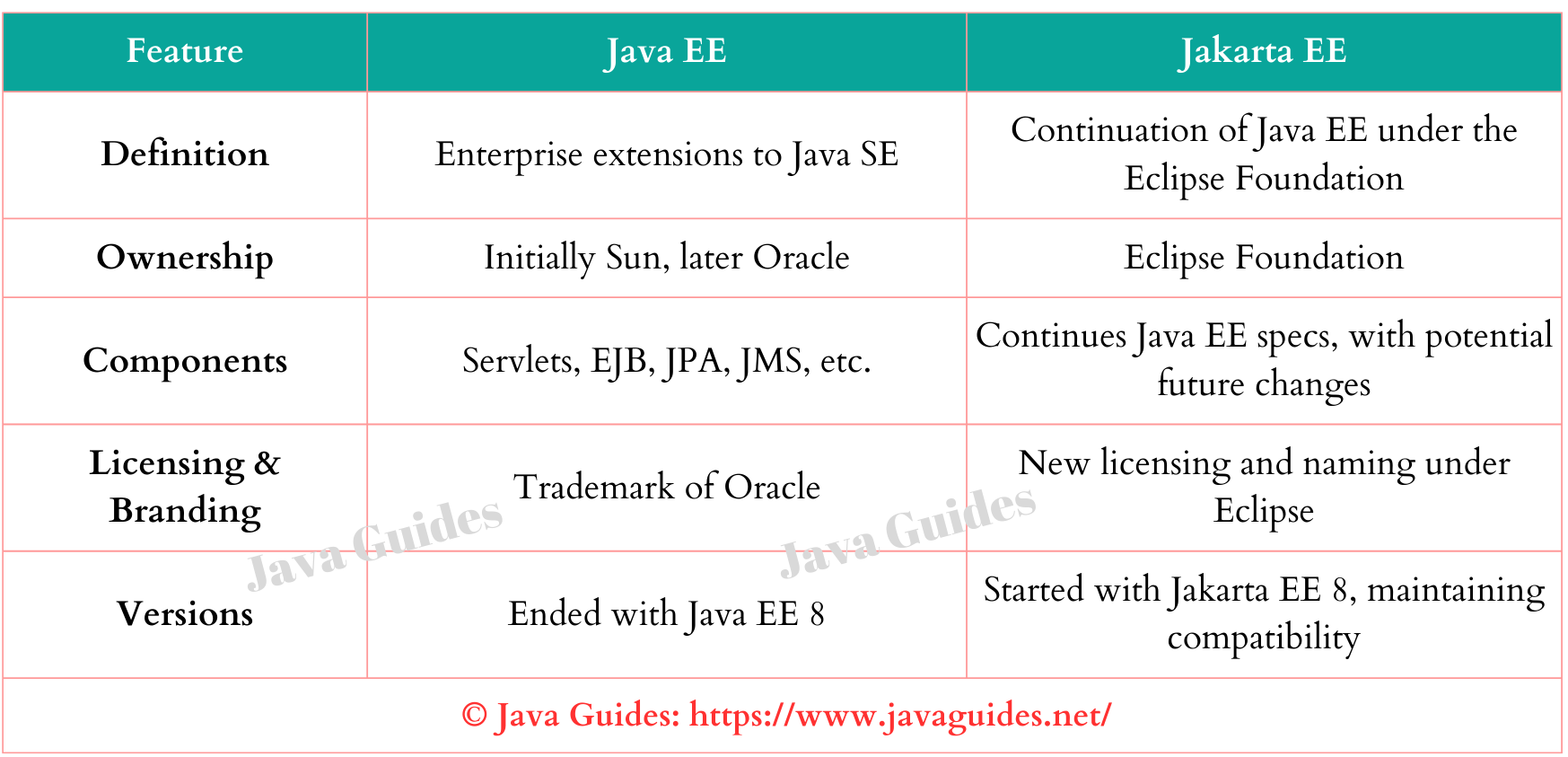🎓 Top 15 Udemy Courses (80-90% Discount): My Udemy Courses - Ramesh Fadatare — All my Udemy courses are real-time and project oriented courses.
▶️ Subscribe to My YouTube Channel (178K+ subscribers): Java Guides on YouTube
▶️ For AI, ChatGPT, Web, Tech, and Generative AI, subscribe to another channel: Ramesh Fadatare on YouTube
Definition: Java EE was a set of specifications that extend the Java SE with specifications for enterprise features such as distributed computing and web services.
Ownership: Java EE was initially developed by Sun Microsystems and later overseen by Oracle.
Components: Java EE included technologies like Servlets, EJB (Enterprise JavaBeans), JPA (Java Persistence API), JMS (Java Message Service), JSF, and more.
Versions: The last version under the Java EE name was Java EE 8.
Jakarta EE
Definition: Jakarta EE is the continuation of the Java EE project under the stewardship of the Eclipse Foundation.
Ownership: Jakarta EE is managed by the Eclipse Foundation, with the support and collaboration of various industry partners.
Components: Jakarta EE maintains compatibility with Java EE but allows for more open development and potential future changes to the specifications.
Licensing and Branding: The transition to Jakarta EE required changes in licensing and naming due to legal restrictions on the Java name, which remains a trademark of Oracle.
Versions: Jakarta EE 8 was the first official release under the new stewardship, maintaining compatibility with Java EE 8.
Here's a table summarizing the key differences:
| Feature | Java EE | Jakarta EE |
|---|---|---|
| Definition | Enterprise extensions to Java SE | Continuation of Java EE under the Eclipse Foundation |
| Ownership | Initially Sun, later Oracle | Eclipse Foundation |
| Components | Servlets, EJB, JPA, JMS, etc. | Continues Java EE specs, with potential future changes |
| Licensing & Branding | Trademark of Oracle | New licensing and naming under Eclipse |
| Versions | Ended with Java EE 8 | Started with Jakarta EE 8, maintaining compatibility |
Implications for Developers and Enterprises
Compatibility: Existing Java EE applications can migrate to Jakarta EE without significant changes.
Innovation: The shift to a more community-driven model opens up new possibilities for innovation and responsiveness to industry needs.
Long-Term Support: Jakarta EE ensures continued support and development for the enterprise Java ecosystem.
Conclusion
The transition from Java EE to Jakarta EE marks a pivotal moment in the history of enterprise Java. It reflects a broader industry trend towards community-driven development and open standards. While the technologies remain consistent, the change in governance sets the stage for a more dynamic and responsive future for enterprise Java.
For developers and enterprises alike, Jakarta EE offers a pathway to modern, efficient, and community-aligned development. Embracing Jakarta EE means participating in a renewed vision for one of the world's most influential and enduring technology platforms.




![[NEW] Full-Stack Java Development with Spring Boot 3 & React Build 5 Spring Boot Projects with Java: Line-by-Line Coding](https://img-c.udemycdn.com/course/750x422/5338984_4d3a_5.jpg)











Comments
Post a Comment
Leave Comment